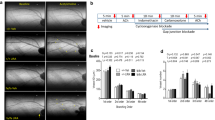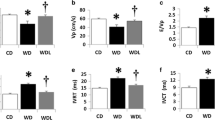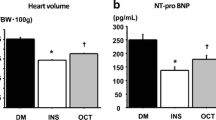Abstract
Aims
Compound 21 (C21), selective AT2 receptor agonist, has cardioprotective effects in experimental models of hypertension and myocardial infarction. The aims of the study was to evaluate the effect of C21, losartan, or both in Zucker diabetic fatty (ZDF) rats (type 2 diabetes) on (1) the prevention of myocardial hypertrophy; (2) myocardial expression of phosphatase and tensin homolog (PTEN), a target gene of miR-30a-3p, involved in myocardial remodelling.
Methods
Experiments were performed in ZDF (n = 33) and in control Lean (8) rats. From the 6th to the 20th week of age, we administered C21 (0.3 mg/kg/day) to 8 ZDF rats. 8 ZDF rats were treated with losartan (10 mg/kg/day), 8 rats underwent combination treatment, C21+ losartan, and 9 ZDF rats were left untreated. Blood glucose and blood pressure were measured every 4 weeks. At the end of the study the hearts were removed, the apex was cut for the quantification of PTEN mRNA and miR-30a-3p expression (realtime-PCR). Myocardial hypertrophy was evaluated by histomorphometric analysis, and nitrotyrosine expression (as marker of oxidative stress) by immunohistochemistry.
Results
ZDF rats had higher blood glucose (p < 0.0001) with respect to control Lean rats, while blood pressure did not change. Both parameters were not modified by C21 treatment, while losartan and losartan + C21 reduced blood pressure in ZDF rats (p < 0.05). miR-30a-3p expression was increased in ZDF rats (p < 0.01) and PTEN mRNA expression was decreased (p < 0.05). ZDF rats developed myocardial hypertrophy (p < 0.01) and increased oxidative stress (p < 0.01), both were prevented by C21 or losartan, or combination treatment. C21 or losartan normalized the expression of miR-30a-3p and PTEN.
Conclusions
Activation of AT2 receptors or AT1 receptor blockade prevents the development of myocardial hypertrophy in ZDF rats. This occurs through the modulation of the miR-30a-3p/PTEN interaction.



Similar content being viewed by others
References
Hu FB (2011) Globalization of diabetes. The role of diet, lifestyle, and genes. Diabetes Care 34:1249–1257. https://doi.org/10.2337/dc11-0442
Zimmet PZ, Magliano DJ, Herman WH, Shaw JE (2014) Diabetes: a 21st century challenge. Lancet Diabetes Endocrinol 2:56–64. https://doi.org/10.1016/S2213-8587(13)70112-8
UKPDS Group (1998) Tight blood pressure control and risk of macrovascular and microvascular complications in type 2 diabetes: UKPDS 38. BMJ 317:703–713
Lorber D (2014) Importance of cardiovascular disease risk management in patients with type 2 diabetes mellitus. Diabetes Metab Syndr Obes 7:169–183. https://doi.org/10.2147/DMSO.S61438
Jia G, Whaley-Connell A, Sowers JR (2018) Diabetic cardiomyopathy: a hyperglycaemia and insulin-resistance-induced heart disease. Diabetologia 61:21–28. https://doi.org/10.1007/s00125-017-4390-4
Dhalla NS, Liu X, Panagia V, Takeda N (1998) Subcellular remodeling and heart dysfunction in chronic diabetes. Cardiovasc Res 40:239–247
Mancia G, Fagard R, Narkiewicz K et al (2013) 2013 ESH/ESC guidelines for the management of arterial hypertension: the task force for the management of arterial hypertension of the European Society of Hypertension (ESH) and of the European Society of Cardiology (ESC). J Hypertens 31:1281–1357. https://doi.org/10.1097/01.hjh.0000431740.32696.cc
Borghi C, SIIA Task Force, Rossi F, SIF Task Force (2015) Role of the renin-angiotensin-aldosterone system and its pharmacological inhibitors in cardiovascular diseases: complex and critical issues. High Blood Press Cardiovasc Prev 22:429–444. https://doi.org/10.1007/s40292-015-0120-5
McCarthy CA, Widdop RE, Denton KM, Jones ES (2013) Update on the angiotensin AT2 receptor. Curr Hypertens Rep 15:25–30. https://doi.org/10.1007/s11906-012-0321-4
Ali Q, Wu Y, Hussain T (2013) Chronic AT2 receptor activation increases renal ACE2 activity, attenuates AT1 receptor function and blood pressure in obese Zucker rats. Kidney Int 84:931–939. https://doi.org/10.1038/ki.2013.193
Rompe F, Artuc M, Hallberg A et al (2010) Direct angiotensin II type 2 receptor stimulation acts anti-inflammatory through epoxyeicosatrienoic acid and inhibition of nuclear factor kappaB. Hypertension 55:924–931. https://doi.org/10.1161/HYPERTENSIONAHA.109.147843
Kaschina E, Grzesiak A, Li J et al (2008) Angiotensin II type 2 receptor stimulation: a novel option of therapeutic interference with the renin-angiotensin system in myocardial infarction? Circulation 118:2523–2532. https://doi.org/10.1161/CIRCULATIONAHA.108.784868
Lauer D, Slavic S, Sommerfeld M et al (2014) Angiotensin type 2 receptor stimulation ameliorates left ventricular fibrosis and dysfunction via regulation of tissue inhibitor of matrix metalloproteinase 1/matrix metalloproteinase 9 axis and transforming growth factor β1 in the rat heart. Hypertension 63:e60–e67. https://doi.org/10.1161/HYPERTENSIONAHA.113.02522
Unger T, Dahlöf B (2010) Compound 21, the first orally active, selective agonist of the angiotensin type 2 receptor (AT2): implications for AT2 receptor research and therapeutic potential. J Renin Angiotensin Aldosterone Syst 11:75–77. https://doi.org/10.1177/1470320309347792
Kaschina E, Namsolleck P, Unger T (2017) AT2 receptors in cardiovascular and renal diseases. Pharmacol Res 125:39–47. https://doi.org/10.1016/j.phrs.2017.07.008
Castoldi G, di Gioia CR, Carletti R et al (2016) Angiotensin type-2 (AT-2)-receptor activation reduces renal fibrosis in cyclosporine nephropathy: evidence for blood-pressure independent effect. Biosci Rep 36:e00403. https://doi.org/10.1042/BSR20160278
Paulis L, Becker ST, Lucht K et al (2012) Direct angiotensin II type 2 receptor stimulation in Nω-nitro-L-arginine-methyl ester-induced hypertension. The effect on pulse wave velocity and aortic remodeling. Hypertension 59:485–492. https://doi.org/10.1161/HYPERTENSIONAHA.111.185496
Rehman A, Leibowitz A, Yamamoto N, Rautureau Y, Paradis P, Schiffrin EL (2012) Angiotensin type 2 receptor agonist compound 21 reduces vascular injury and myocardial fibrosis in stroke-prone spontaneously hypertensive rats. Hypertension 59:291–299. https://doi.org/10.1161/HYPERTENSIONAHA.111.180158
Bartel DP (2004) MicroRNAs: genomics, biogenesis, mechanism, and function. Cell 116:281–297
Huntzinger E, Izaurralde E (2011) Gene silencing by microRNAs: contributions of translational repression and mRNA decay. Nat Rev Genet 12:99–110. https://doi.org/10.1038/nrg2936
Guo H, Ingolia NT, Weissman JS, Bartel DP (2010) Mammalian microRNAs predominantly act to decrease target mRNA levels. Nature 466:835–840. https://doi.org/10.1038/nature09267
Duisters RF, Tijsen AJ, Schroen B et al (2009) miR-133 and miR-30 regulate connective tissue growth factor: implications for a role of microRNAs in myocardial matrix remodeling. Circ Res 104:170–178. https://doi.org/10.1161/CIRCRESAHA.108.182535
Castoldi G, Di Gioia CR, Bombardi C et al (2012) MiR-133a regulates collagen 1A1: potential role of miR-133a in myocardial fibrosis in angiotensin II-dependent hypertension. J Cell Physiol 227:850–856. https://doi.org/10.1002/jcp.22939
Guan X, Wang L, Liu Z et al (2016) miR-106a promotes cardiac hypertrophy by targeting mitofusin 2. J Mol Cell Cardiol 99:207–217. https://doi.org/10.1016/j.yjmcc.2016.08.016
Zheng D, Ma J, Yu Y et al (2015) Silencing of miR-195 reduces diabetic cardiomyopathy in C57BL/6 mice. Diabetologia 58:1949–1958. https://doi.org/10.1007/s00125-015-3622-8
Yang SJ, Yang SY, Wang DD et al (2017) The miR-30 family: versatile players in breast cancer. Tumor Biol 39:1–13. https://doi.org/10.1177/1010428317692204
Pan W, Zhong Y, Cheng C et al (2013) MiR-30-regulated autophagy mediates angiotensin II-induced myocardial hypertrophy. PLoS One 8:e53950. https://doi.org/10.1371/journal.pone.0053950
Yin X, Peng C, Ning W et al (2013) miR-30a downregulation aggravates pressure overload-induced cardiomyocyte hypertrophy. Mol Cell Biochem 379:1–6. https://doi.org/10.1007/s11010-012-1552-z
Peterson RG, Shaw WN, Neel MA, Little LA, Eichberg J (1990) Zucker diabetic fatty rat as a model for non-insulin dependent diabetes mellitus. ILAR J 32:16–19. https://doi.org/10.1093/ilar.32.3.16
King AJ (2012) The use of animal models in diabetes research. Br J Pharmacol 166:877–894. https://doi.org/10.1111/j.1476-5381.2012.01911.x
Castoldi G, di Gioia CR, Bombardi C et al (2014) Prevention of diabetic nephropathy by compound 21, selective agonist of angiotensin type 2 receptors, in Zucker diabetic fatty rats. Am J Physiol Renal Physiol 307:F1123–F1131. https://doi.org/10.1152/ajprenal.00247.2014
Castoldi G, di Gioia CR, Giollo F et al (2016) Different regulation of miR-29a-3p in glomeruli and tubules in an experimental model of angiotensin II-dependent hypertension: potential role in renal fibrosis. Clin Exp Pharmacol Physiol 43:335–342. https://doi.org/10.1111/1440-1681.12532
Karginov FV, Hannon GJ (2013) Remodeling of Ago2-mRNA interactions upon cellular stress reflects miRNA complementarity and correlates with altered translation rates. Genes Develop 27:1624–1632. https://doi.org/10.1101/gad.215939.113
Tate M, Grieve DJ, Ritchie RH (2017) Are targeted therapies for diabetic cardiomyopathy on the horizon? Clin Sci 131:897–915. https://doi.org/10.1042/CS20160491
Paulis L, Foulquier S, Namsolleck P, Recarti C, Steckelings UM, Unger T (2016) Combined angiotensin receptor modulation in the management of cardio-metabolic disorders. Drugs 76:1–12. https://doi.org/10.1007/s40265-015-0509-4
Shum M, Pinard S, Guimond MO et al (2013) Angiotensin II type 2 receptor promotes adipocyte differentiation and restores adipocyte size in high-fat/high-fructose diet-induced insulin resistance in rats. Am J Physiol Endocrinol Metab 304(2):E197–E210. https://doi.org/10.1152/ajpendo.00149.2012
Ohshima K, Mogi M, **g F et al (2012) Direct angiotensin II type 2 receptor stimulation ameliorates insulin resistance in type 2 diabetes mice with PPARγ activation. PLoS One 7(11):e48387. https://doi.org/10.1371/journal.pone.0048387
Shao C, Yu L, Gao L (2014) Activation of angiotensin type 2 receptors partially ameliorates streptozotocin-induced diabetes in male rats by islet protection. Endocrinology 155(3):793–804. https://doi.org/10.1210/en.2013-1601
Guo R, Nair S (2017) Role of microRNA in diabetic cardiomyopathy: from mechanism to intervention. BBA Mol Basis Dis 1863:2070–2077. https://doi.org/10.1016/j.bbadis.2017.03.013
Kato M, Natarajan R (2015) MicroRNAs in diabetic nephropathy: functions, biomarkers, and therapeutic targets. Ann N Y Acad Sci 1353:72–88. https://doi.org/10.1111/nyas.12758
Wang W, Lin H, Zhou L et al (2014) MicroRNA-30a-3p inhibits tumor proliferation, invasiveness and metastasis and is downregulated in hepatocellular carcinoma. EJSO 40:1586–1594. https://doi.org/10.1016/j.ejso.2013.11.008
Li W, Dai H, Ou Q, Zuo GQ, Liu CA (2016) Overexpression of microRNA-30a-5p inhibits liver cancer cell proliferation and induces apoptosis by targeting MTDH/PTEN/AKT pathway. Tumor Biol 37:5885–5895. https://doi.org/10.1007/s13277-015-4456-1
Oudit GY, Penninger JM (2009) Cardiac regulation by phosphoinositide 3-kinases and PTEN. Cardiovasc Res 82:250–260. https://doi.org/10.1093/cvr/cvp014
Gao S, Park BM, Cha SA, Park WH, Park BH, Kim SH (2013) Angiotensin AT2 receptor agonist stimulates high stretch induced- ANP secretion via PI3K/NO/sGC/PKG/pathway. Peptides 47:36–44. https://doi.org/10.1016/j.peptides.2013.06.008
Savoia C, Ebrahimian T, He Y, Gratton JP, Schiffrin EL, Touyz RM (2006) Angiotensin II/AT2 receptor-induced vasodilation in stroke-prone spontaneously hypertensive rats involves nitric oxide and cGMP-dependent protein kinase. J Hypertens 24(12):2417–2422. https://doi.org/10.1097/01.hjh.0000251902.85675.7e
Sánchez A, Contreras C, Climent B et al (2018) Impaired Ca2+ handling in resistance arteries from genetically obese Zucker rats: Role of the PI3K, ERK1/2 and PKC signaling pathways. Biochem Pharmacol 152:114–128. https://doi.org/10.1016/j.bcp.2018.03.020
Author information
Authors and Affiliations
Corresponding author
Ethics declarations
Conflict of interest
The authors declare that they have no conflict of interest.
Ethical approval
Animal studies were in conformity with the Institutional Guidelines in compliance with National laws and policies (D.L.n. 116, Gazzetta Ufficiale della Repubblica Italiana, suppl.40, Feb.18, 1992) and experiments were performed in accordance with the Guide for the Care and Use of Laboratory Animals published by the US National Institutes of Health (NIH Publication No. 85-23, revised 1996).
Informed Consent
For this type of study (experimental study on animal model) it is not required.
Additional information
Managed by Massimo Porta.
Rights and permissions
About this article
Cite this article
Castoldi, G., di Gioia, C.R.T., Roma, F. et al. Activation of angiotensin type 2 (AT2) receptors prevents myocardial hypertrophy in Zucker diabetic fatty rats. Acta Diabetol 56, 97–104 (2019). https://doi.org/10.1007/s00592-018-1220-1
Received:
Accepted:
Published:
Issue Date:
DOI: https://doi.org/10.1007/s00592-018-1220-1




